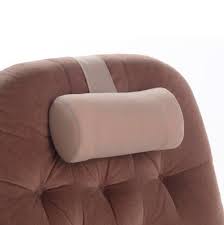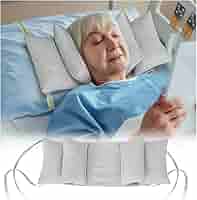

Whether you are working long hours at your desk, relaxing with a book, or watching a movie on the couch, one thing becomes crystal clear with time: your neck deserves better support.
Prolonged sitting, especially in poorly aligned postures, can wreak havoc on your cervical spine. Enter the humble cushion—often overlooked, but when used strategically, it can be a game-changer for neck health.
But it is not just about tossing a pillow behind your head and hoping for the best. Supporting your neck while sitting requires a thoughtful approach, and yes, the right cushion used the right way.
In this article, Best Forward Head Posture Fix research team would explore the proper use of cushions to support the neck when seated.
We would not be discussing standing or sleeping postures—just sitting, whether at a desk, in a car, or on a sofa.
The goal?
To prevent stiffness, pain, and that nagging “tech neck” feeling that’s become all too common in the digital age.
We would walk you through this process step by step, using ergonomic science, real-world practicality, and a few surprisingly simple hacks.
Let us get your neck the comfort it has been craving.
Points Covered in This Article:
- Understanding the Importance of Neck Support While Sitting
- Choosing the Right Cushion for Seated Neck Support
- Positioning the Cushion on a High-Back Chair
- Using a Cushion in a Low-Back Chair or Stool
- Supporting Your Neck While Sitting on a Couch
- Car Seat Neck Cushion Setup Explained
- Adjusting Cushion Height and Thickness for Proper Neck Alignment
- DIY Cushion Hacks for Neck Support While Sitting
- How to Pair Neck Cushions with Lumbar Support
- FAQs on Cushion for Fixing Forward Head Posture
- Mistakes to Avoid When Using Cushions for Neck Support
Understanding the Importance of Neck Support While Sitting
Before we dive into the how-to, it is essential to understand why neck support matters when you are seated.
Sitting for long periods without proper neck support can lead to cervical strain, tension headaches, and even numbness in the shoulders or arms.
According to recent ergonomics research, a poorly supported neck can tilt forward by as much as 45 degrees while using a phone or laptop, dramatically increasing the load on cervical discs.
The phrase “neck pain relief cushion for office chair” is not trending on search engines for nothing. People are seeking ways to counteract poor posture habits, especially with remote work becoming the norm.
Supporting the cervical spine maintains the natural curvature of your neck and reduces muscular strain. So yes, your neck will thank you.
Choosing the Right Cushion for Seated Neck Support
Not all cushions are created equal. When it comes to supporting your neck while sitting, the cushion you choose can either be your best friend or an underwhelming fluff ball.
For optimal comfort, consider a memory foam cushion that molds to your neck shape. Look for features like ergonomic contours, removable covers, and breathable fabric.
Many consumers look up the term “orthopedic neck cushion for sitting posture” to find cushions designed with medical-grade support.
Travel neck pillows, cervical rolls, and contoured back cushions with extended neck support are ideal options. The cushion should not be too soft, as that can collapse under pressure, nor too firm, which may cause discomfort.
Positioning the Cushion on a High-Back Chair
When sitting in a high-back chair—like an executive desk chair—the backrest often supports your mid and upper back but not your neck.
That is where a cushion comes into play. To set up a “high back chair neck cushion support,” position a U-shaped or contoured cushion at the curve of your neck where it naturally rests.
Make sure the cushion does not push your head forward. Instead, it should cradle the base of your skull and support the cervical spine without altering its curve.
If you wear glasses or use a headset, test the setup for comfort during extended sitting sessions. Adjust the height until your neck feels neutrally aligned, not hyperextended.
Using a Cushion in a Low-Back Chair or Stool
Low-back chairs and stools often neglect upper back and neck support altogether, making them prime culprits in posture breakdown. In this situation, you would want to mimic a full-back chair setup using strategic cushions. The keyword “neck support cushion for low back seat” frequently appears in search trends, and for good reason.
Start by placing a rolled towel or cylindrical neck pillow vertically against the back of the chair, extending up to your neck.
Sit down and ensure your shoulders are pulled slightly back and your head rests comfortably. If the chair back is too low, a cushion with a Velcro strap can secure the pillow in place to prevent slipping.
Supporting Your Neck While Sitting on a Couch
Couches are notorious for encouraging slouchy, neck-straining postures—especially when binge-watching your favorite show.
Soft couches fail to maintain proper neck posture, which often lead to neck and upper back pain.
To achieve proper “couch neck cushion support for relaxing,” use a firm yet plush cushion at the back of your neck while sitting upright.
A wedge cushion can also work wonders for improving the angle between your lower back and upper body.
Place a neck roll horizontally at shoulder height to keep your neck supported without arching forward.
Avoid overstuffed throw pillows, as they may lift your head too high, distorting the cervical curve.
Car Seat Neck Cushion Setup Explained
Long drives can be brutal on the neck, especially with poorly designed car seats.
Drivers and passengers alike often turn to “car seat neck cushion for long sitting comfort” to reduce strain. To set this up, use a memory foam neck pillow that attaches securely to the headrest.
The cushion should align with the base of your skull—not push your head forward. Some newer car cushions come with adjustable straps to modify height.
Do not rely solely on the built-in headrest; it is often too firm and misaligned for real support. A cushion should fill the gap between your neck and the seat’s back, especially during extended travel.
Adjusting Cushion Height and Thickness for Proper Neck Alignment
Even the best cushion will be ineffective if it is too thick or too thin.
Ideally, your ears should align vertically over your shoulders when seated.
The goal of a “neck alignment cushion for ergonomic seating” is to preserve this straight posture while relaxing.
For smaller individuals, a thinner cushion may suffice, while those with longer necks or broader shoulders might require more padding.
Try different positions and adjust incrementally until your head rests comfortably without tilting forward or backward. Test this by placing a hand behind your neck—if the pressure feels even, you have likely got it right.
DIY Cushion Hacks for Neck Support While Sitting
No fancy equipment? No problem.
You can make your own “DIY neck support pillow for seated comfort” using household items. A rolled towel secured with rubber bands or a small firm blanket folded lengthwise can act as a neck roll. Wrap it in a soft pillowcase for extra comfort.
You can also stuff a long sock with rice or foam bits and tie both ends—it works surprisingly well. These DIY options are particularly useful when traveling, working remotely, or lounging on an informal seating surface where ergonomics aren’t top priority but still matter.
How to Pair Neck Cushions with Lumbar Support?
Your neck and lower back are biomechanical partners in crime.
That is why integrating lumbar support in chair is essential when focusing on “neck and back cushion combo for sitting posture.”
When the lumbar spine is unsupported, the upper back rounds and the neck protrudes forward.
Start by placing a lumbar roll at your lower back, then adjust your neck cushion to balance the alignment. Together, they maintain the spine’s natural S-curve and prevent slouching.
Make sure both cushions are secured and don’t shift easily. This dual support setup is ideal for long desk sessions or car rides.
Mistakes to Avoid When Using Cushions for Neck Support
Finally, let us talk about what not to do. After all, you need to learn how to choose the right pillow to fix your nerd neck.
One of the most common errors in “cushion placement for neck pain during sitting” is using a cushion that pushes the head too far forward or one that’s too tall. This misalignment stresses the neck and worsens posture over time.
Avoid soft, shapeless pillows that collapse under pressure.
Do not rely on armrests or leaning your head against the wall, which promotes unnatural tilting. Also, do not position the cushion too low—it should support the cervical curve, not the shoulders or mid-back.
FAQs on Cushion for Fixing Forward Head Posture
Q-1: Where exactly should a neck cushion sit when you’re at a desk?
A-1: Nestle a small, compliant cushion into the hollow where your upper back meets the base of your neck—never under the skull and never against the throat. Its job is to cue a neutral head (ears over shoulders), not to prop the head up. After placing it, ensure your screen is at or just below eye level, your chair height lets feet rest flat, and your elbows hang close to your sides so the cushion isn’t fighting poor desk setup.
Q-2: How thick and firm should the cushion be to avoid pushing the chin forward?
A-2: Think “support, not shove.” A 2–4 cm loft with soft-to-medium firmness usually works. Do a quick check: look straight ahead, then let only your eyes—not your head—drop to mid-screen. If you must tilt the head, the cushion is too tall or too firm. Lower the loft slightly and add a modest monitor back-tilt (about a hand’s breadth under the top edge) so your gaze stays neutral without chin-jutting.
Q-3: How do I pair a neck cushion with lumbar support without over-arching my back?
A-3: Set your lumbar first so the pelvis is neutral (neither slumped nor sway-backed). Then add the neck cushion just enough to meet your upper back; your breastbone should feel light, not lifted. If you find yourself leaning toward the screen after both supports are in place, increase text size or bring the monitor to arm’s length instead of piling on more neck pressure.
Q-4: Can I use a neck cushion in the car, and what should I change in my seat setup?
A-4: Yes—use a slim roll at the upper neck so your head still contacts the head restraint in a natural posture. Raise the head restraint so its top aligns with the top of your head and position it close enough to touch lightly. Keep shoulders against the seatback, and avoid thick pillows that push your head forward and away from the restraint; that reduces protection and often increases neck strain.
Q-5: What routine helps the cushion support posture without creating dependence?
A-5: Treat it like a gentle reminder, not a brace. Use it during slouch-prone tasks (email, long calls), then break every 20–30 minutes for 1–3 minutes of movement. Between bouts, do two quick sets: chin tucks (8 slow reps), scapular retractions (12 reps), and a doorway chest stretch (30 seconds). If you notice lingering skin marks, tingling, or dizziness, reduce time or loft and reassess your chair and screen setup before re-trying.
Bottom line: A neck cushion works best when it fills the natural curve, not when it forces position. Dial in chair, screen, and keyboard first; use the cushion as a light cue; and sprinkle short movement breaks to keep your neck comfortable and aligned.
Always adjust based on your seating context and body proportions.
What We Learn from this Article?
Supporting your neck while sitting does not require a complete ergonomic overhaul—just a well-placed cushion and a little anatomical awareness.
From office chairs to car seats, the right cushion can help you maintain spinal alignment, reduce fatigue, and even boost concentration during long tasks.
Each step we have explored offers a practical strategy to enhance comfort and prevent neck strain, using nothing more than what is already within reach.
Whether you are hunting for the best “car seat neck cushion for sitting posture” or inventing your own DIY solution, the principles remain the same: maintain alignment, provide gentle yet firm support, and ensure that your neck follows its natural curve.
So next time you sit, remember—it is not just your back that needs love. Your neck deserves it too.
A simple cushion could be the unsung hero of your seated comfort.
References:

